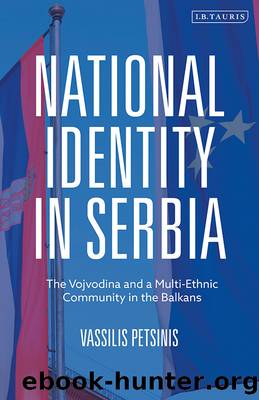National Identity in Serbia: The Vojvodina and a Multi-Ethnic Community in the Balkans by Vassilis Petsinis

Author:Vassilis Petsinis [Petsinis, Vassilis]
Language: eng
Format: epub
Tags: Communism; Post-Communism & Socialism, Political Ideologies, Political Science, Nationalism & Patriotism, Geopolitics, Human Rights
ISBN: 9781788317085
Google: M3C1DwAAQBAJ
Goodreads: 43804429
Publisher: I.B. Tauris
Published: 2019-12-12T00:00:00+00:00
Source: http://www.cesid.org.
Apart from that, no notable changes in the local bases of support of other political forces became evident in the November 1996 elections. SRS, for instance, remained powerful â though not dominant â in the municipalities of Srem where a dense concentration of colonists and refugees is observed (Table 12). Moreover, the voting procedure in the northern BaÄka and Banat municipalities with a Hungarian local majority once again took place in ethnic terms at all levels (Table 12). Finally, Zajedno remained quite popular in certain predominantly old settler-populated municipalities (though not to the extent that DEPOS was some years ago), whereas the regionalists still proved themselves a noteworthy political force in quite a few ethnically mixed constituencies (Table 12). Overall, the 1996 elections in Vojvodina can be regarded as âelections of continuityâ by most aspects.
Almost identical was the case at the 1997 Serbian elections. In these elections, the âleftâ coalition won 28.81 per cent of the vote and elected twenty-two mandates to the Serbian parliament. SRS came second with 28.52 per cent of the vote (21 mandates) and SPO had a disappointing performance with 9.73 per cent of the vote and only four mandates to the Serbian parliament. An interesting incidence was the rather decent performance of the Koalicija Vojvodina (11.37 per cent of the vote). As for the presidential race, in most constituencies, it turned into a question of SPSâNDâJUL versus the Radicals. Finally, VMSZ won 5.15 per cent of the total vote.
As far as the negative performance by SPO was concerned, it had to do with Vuk DraÅ¡koviÄâs increasingly discredited image as the leader of the âdemocratic oppositionâ throughout Serbia. On the other hand, the Radicalsâ startling performance was much subject to the fact that, as a result of the DSSâs boycott of the procedure, no moderate nationalist option was available in these elections. This, in combination with the SPOâs diminishing popular appeal, might have accounted for the diversion of a certain percentage of voters, who had previously voted for Zajedno, towards SRS. With specific regard to the SRS voters, a larger percentage among them (especially in Srem) voted for the party in the 1997 Serbian elections than in the 1996 Yugoslav ones (Table 12). Quite similar was the case in 1992, when a larger percentage of the Radicalsâ voters in Vojvodina voted for them in the Serbian elections than in the Yugoslav ones, which were held at the same time. Therefore, it seems that a greater percentage of SRS voters in Vojvodina were interested in their party securing a firmer place in the Serbian parliament, largely because of the way that the constitutional structure of Serbia and FR Yugoslavia was set up.
As far as the performance of Koalicija Vojvodina was concerned, one explanation that can be given is that it was also affected by the boycott of the elections by certain parties. In other words, it is quite likely that a certain percentage of voters previously affiliated to DS voted for the regionalist coalition. A complementary
Download
This site does not store any files on its server. We only index and link to content provided by other sites. Please contact the content providers to delete copyright contents if any and email us, we'll remove relevant links or contents immediately.
| Anarchism | Communism & Socialism |
| Conservatism & Liberalism | Democracy |
| Fascism | Libertarianism |
| Nationalism | Radicalism |
| Utopian |
The Secret History by Donna Tartt(18694)
The Social Justice Warrior Handbook by Lisa De Pasquale(12069)
Thirteen Reasons Why by Jay Asher(8716)
This Is How You Lose Her by Junot Diaz(6689)
Weapons of Math Destruction by Cathy O'Neil(6068)
Zero to One by Peter Thiel(5618)
Beartown by Fredrik Backman(5533)
The Myth of the Strong Leader by Archie Brown(5358)
The Fire Next Time by James Baldwin(5185)
How Democracies Die by Steven Levitsky & Daniel Ziblatt(5083)
Promise Me, Dad by Joe Biden(5029)
Stone's Rules by Roger Stone(4981)
100 Deadly Skills by Clint Emerson(4785)
A Higher Loyalty: Truth, Lies, and Leadership by James Comey(4768)
Rise and Kill First by Ronen Bergman(4643)
Secrecy World by Jake Bernstein(4584)
The David Icke Guide to the Global Conspiracy (and how to end it) by David Icke(4539)
The Farm by Tom Rob Smith(4397)
The Doomsday Machine by Daniel Ellsberg(4366)
